Last night, was ideal conditions, clear, not too cold, still air. So I setup for a run at M42 with the C80ED. Leveled, powered up and aligned on Betelguese. I used liveview to align and focus. Slewed to M42 and waited for M42 to clear the roof. Then the problems started.
Every single frame was showing mount drive errors. I tried to adjust the scope in the rings, to shift the balance, errors. I powered down and realigned, errors. No matter what I did, I couldn't get rid of the drive errors. I spent some 1.5 hours faffing with it, trying to eliminate the errors. Even setting the camera to 15 seconds didn't work. So, with the cold working it's way between my toes and up my spine, I quit whilst I was behind, packed up and went to warm up.
A quick balance check during the day, today, and I shifted the balance, so that the scope with camera was a little tail heavy. The sky looking clear, I figured it was worth setting up for a bash. Of course, it's window tonight, and the clouds are scudding by. However, I still setup and aligned. Although I didn't bother with trying to align on M42. I just used Betelguese to sort out the drive errors. Even with the shifted balance, I was still seeing tracking errors, but this time, using a lantern I was able to see clearly and make better adjustments. By shifting the OTA backwards in the rings about 1" I was able to take shots up to 60 seconds, that didn't shot drive errors. Totally unusable, thanks to the clouds, and I was getting some star trails, that I think was caused by the gusty wind. After 30 minutes and a fair few test frames I'm confident that this has resolved the drive errors, so a productive night anyway, and I'm pleased with the results.
Saturday, 27 December 2008
Drive Train Errors
Friday, 19 December 2008
The moon from this morning
Nothing much been happening again because of the clouds. It's almost enough to put you off completely. But not that much, the view are too amazing..
Anyway I managed to get the stacks completed after some difficulties with the puter.
M42
M44
Ok as images, they aren't great, too much noise, not enough subs, the M44 image is badly frames. However, that wasn't the intention of the night. The plan had been to get the scope balanced and check out the tracking and operation of the NexStar with the C80ED on it. As you can see it worked well. Also, the scope appears to have a lovely sharp field. The stars look good into the corners.
I'm looking forward to getting a decent number of subs at some point soon on both these targets, and sorting the framing.
This morning, the sky was clear as a bell, and the moon was floating there gracefully. There wasn't enough time for a proper session, so I set the scope on the tripod, put the camera with 2xTC at prime, and grabbed a shot.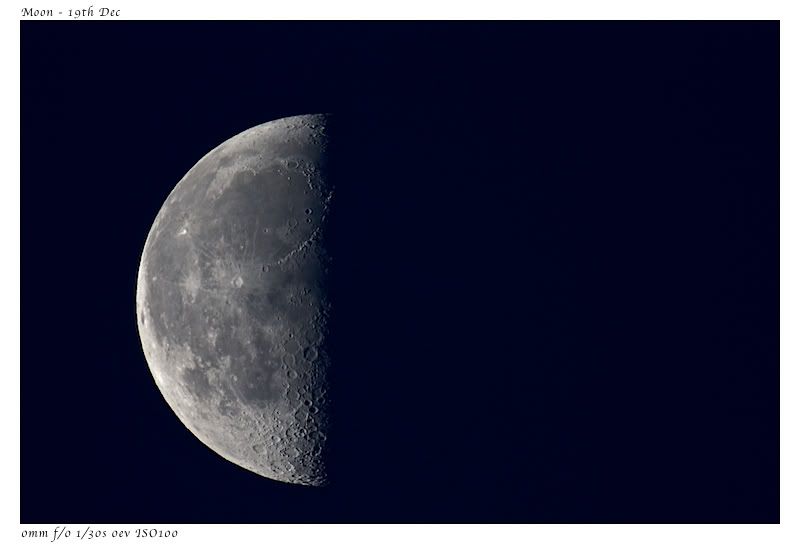
This is working really well, and when I've been able to use it, the scope is great.
Wednesday, 17 December 2008
Activities on the 17th Dec
I finally managed to process the single RAW frame I shot of the moon this morning. I'm pleased with how it came out. I'm not sure, but I think the single RAW is as good as the stacked jpg's. I need to work out how to stack the RAW's
Here's the image
Early this evening, I looked out and could barely see Venus through the mist. Forget any stars. I was expecting that to be that for any astronomical activities, but I was wrong. The mist cleared away, and the sky filled with diamonds. I wasn't sure how long this was going to last, I could see more clouds on the horizon, so I popped the C80ED onto the Manfrotto PortaPod and headed out the front to get a look at M42 before the clouds rolled in.
I didn't start there though, and went highed to get a look at M45. I used the 17mm Hyperion, and I think the FOV was a little too tight, but I wasn't going to leave anything setup out the front whilst I went to get the 24mm Hyperion. Anyway, I had a good long look at the lovely sisters. What a view, clear and sharp pinpoints of light against the dark velvet sky.
I then swung down for a look at M42. Using the 17mm Hyperion I could make out the large shape of the bird of M42. Looking closely I could easily make out 3 of the trap stars with clear seperation between them and I starred for a while.
Then taking a look around I could see that the sky was clear, so I took the scope and portapod through to the backgarden and had a look around. I couldn't get a clear view with this tripod on the Double or the other targets in Perseus or Cassie, as it was too high. I decided that I would grab the NexStar setup and try some imaging. This was really more of a test session as I'd not tried this setup out on a deep sky target.
So, I leveled, powered up, carried out a one star align on Betelguese, and slewed to M42. Whilst I was waiting for the slew to complete I took some flats and flat darks. Then set about getting my lights. I shot a few test frames, and each one had drive errors evident. Hmm, I guessed that the balance on the C80ED in the tube rings wasn't quite right and adjusted it slightly, to provide a slight readward bias. This did the trick. I set the timer remote for 30 seconds and started grabbing data. Mid way through a bunch of clouds wandered through, so that lot were thrown away... As M42 clears my house it's already got a bit to far south for tracking in AltAz to go very long and I lost a few more subs to trailing. I ended up with 6 x 30 second subs. I then set for 2 seconds to try and grab a few subs with the trap. This worked nicely. Whilst I was capturing these a bunch of clouds settled in over Orion... Ah well.
Whilst the scope and camera were busy I used the 10x50's for a look around. The usual suspects, the Double Cluster, M45 and a general wander around the Milky Way. I noticed that Cancer was up and looking through the 10x50's I could clearly see The Beehive. So I sent the NexStar slewing off and grabbed my dark frames, which allowed time for the mount to settle.
Once the darks were complete, I set the timer remote to grab a bunch of frames on M44. I grabbed 30 in total, and lost half to clouds, which settled in and I gave up.
I've done a teeny amount of processing on a single 30s sub to see what it looked like. I can't believe the amount of Neb that has come through in a single frame. I don't know what the bar is, but I noticed it on several 30s subs moving across the frames, so maybe a real slow satellite... Anyway.. Here's the single frame.
I did something similar on M44, although I don't think I've framed it as well. That's ok though as this was a test session anyway. Here's a single frame with a similar amount of processing done.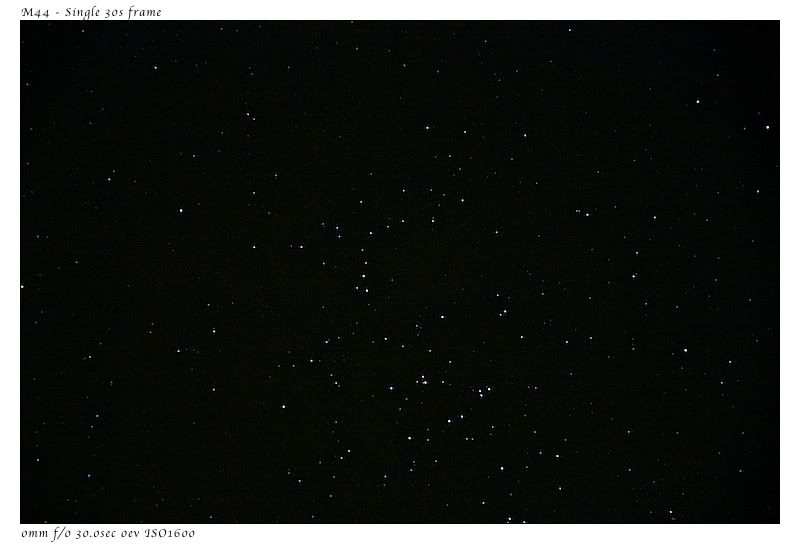
The stack and post processing needs to be completed however on both sets, this will take some time, and I'll post the results as soon as they are available.
This mornings Moon
For the first time in what feels like weeks, but in reality is less than one, it's enough to drive you nuts, I woke up this morning and the sky was clear and I could see the moon. Well, I swapped the C80ED onto my PortaPod, popped the 450d at prime with the OM mount 2x Teleconverter and headed into the garden. I grabbed a shot in RAW, that I've yet to process, and 10 jpg's to try and stack. Had a bit of a wild time with the stacking tools. Registax was unable to cope with the images being all of the shop (I had to keep moving the tripod head to keep the moon in frame), avistack did the same thing. CombineZ and DSS handled it perfectly. I tried 2 mechanisms in CombineZ and after a couple of tweaks in GIMP to boost contrast and sharpen I got.
Normal CombineZ
Pyramid Contrast Enhanced (I've no idea what this means, but it sounded good)
DSS (this had to be darkened down a bit)
I'm not sure which has worked the best, but it was interesting to see the results. I have yet to process the RAW image.
Thursday, 11 December 2008
C80ED, second light.
Despite the cloud that kept drifting through early evening, threatening to spoil the night completely. At about 9pm, it was thin enough, and the moon bright enough, I decided to set up and have a look see anyway. After the usual, level, and power up, I aligned on the moon, this time taking more care to be as precise as could be, not easy with a 5mm ortho, on getting the centre aligned. Then I popped in the 5mm Hyperion with twin tuning rings (making 2.5mm) and started having a look around. With the cloud, the conditions weren't good enough for that much power (x240), so I removed the 14mm tuning ring making it a 3.5mm ep (x172) and used that instead. Firstly, as I slewed across the surface, I was again astonished by the amount of texture that the view provided. The fully lit main section of the moon was showing in an almost 3d way, with the rays from Tycho looking almost like deep troughs across the surface. I drifted across the terminator and pondered the mountains whose peaks were just showing in the light, an eerie and amazing sight. Then started looking properly with the "New Atlas of the Moon" out.
I started at Aristarchus, it's amazing how bright this crater is compared to the surrounding area. Then found Prinz. I'd forgotten about the oddities of direction induced using a refractor and diagonal, and using the map for a reflector and kept moving in the wrong direction. Ah well, that soon passed. Then I found Reiner and Reiner gamma and onto Cavalerius. This of course led neatly into Hevelius and Grimaldi. I recall when I first found Grimaldi, how much difficulty I had making it out with the Vista, no problems at all last night with the ED80. Clear and sharp. Gassendi was clear and easy to find and I found Sirsalis too. Then, to be honest, I got fed up with keep taking my eye away from the ep to check in the atlas and make notes, there'll be plenty of time for that, and just meandered my way around, in amongst the craters, seas, mountains and oceans admiring the crispness of the view.
I then grabbed the 450d, bolted on the OM adapter and OM 2xTC and nose piece and shot a few of the moon at 1200mm. It was a little tricky getting the settings right as the thin cloud was causing changing light, but I got it.
After finishing I had a go at a colouring of the moon, to pull out the natural surface colours
I then set the camera to take 10 shots on it's self timer and took a bunch of them in jpg to attempt to stack. I haven't had a chance to do this as yet, but I'll post the results as soon as I have.
I then decide to do a little more analytical testing to find out what this scope was really like on the stars. I slewed to Betelguese, just showing over the roof, keeping the 5mm Hyperion (at 3.5mm) and popped the star inside and outside of focus. The rings looked spot on both sides of focus, and the colour of Betelguese was really vivid with the crisp and sharp view.
I tried to get a look at a couple of clusters, but the clouds and the moon were having none of it, but the views through the 17 and 24 mm Hyperions were equally as impressive. However, Castor and Pollux were visible so I decided to test the scope on Castor, as it's a double star, and using the 5mm+tr, I could clearly make out the secondary and a most definite gap between them, both stars being pinpoints of light.
I then slewed around to have a look at M42, but this was not to be, I'd been spotted again by the cloud pixies and within moments of pointing the scope in the right direction, was clouded out.
I used the 6x30 finder scope, and whilst it will take a little getting used to, and is slightly harder to use than an RDF, it's very clear views, and erect image optics make it a useful tool.
Processing the AVI's
I had some real problems processing the AVI's from last nights session. I think I know why. I wasn't very precise with the scope alignment on the moon and had a lot of drift in frame. Ho hum. I managed to get results from 2 of the 7 AVI's, I had the settings right.
First off the Tycho region at 600mm
then Reiner and Reiner Gamme at 3000mm (using the Antares 5x Barlow)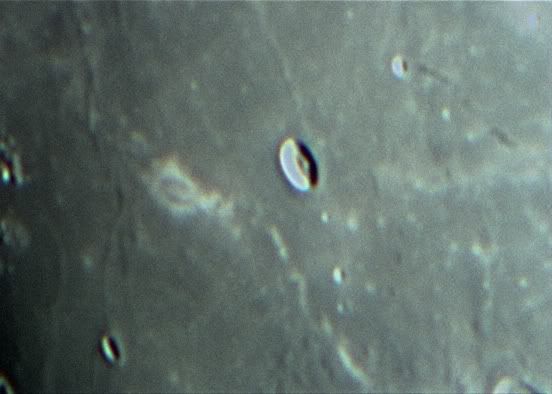
I had to crop the edges on this due to the drift in the image causing lines on the edges. Must remember to make sure that the alignment on the lunar centre is more accurate.
Wednesday, 10 December 2008
Testing the C80ED
Oh boy, what a Telescope. I got this on offer from FLO and it arrived yesterday. Today was my first opportunity to setup and test. First impressions, this is a well built solid instrument. The tube, focuser, focus knobs, adapters and even the dew shield are all metal. This puts the weight up, but it's only 1/2 Kg heavier than the Konus for all that. The focus knobs are about twice the diameter of the Konus, so whilst this has a single speed rack and pinion focuser, the action is very smooth, with far more fine ability and appears to have no slack at all. The 6x30 finder is clear, operates in a normal upright mode (this caused me real problems with the original Konus finder) is clear and bright, and has a well made metal mount with spring loaded alignment. The scope sits snugly in the tuberings on my existing NexStar SLT mount, and the colours match perfectly, down the writing around the dew shield matching the stripe on the mount.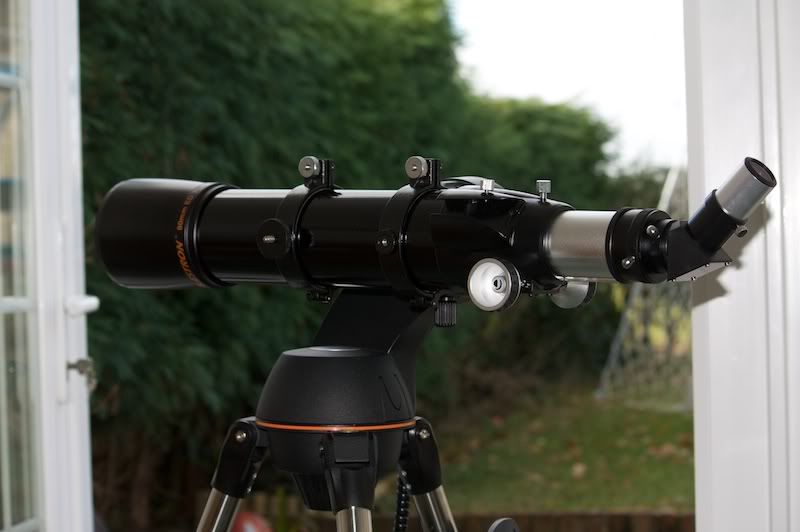
I used the fence some way away as a test for my daylight setup. Shot using the 450d at prime focus. 
And a second one using my 2x TC
Visually, the same view was crisp and precise using both the 6.5mm Ortho and the 5mm Hyperion. I had some CA creep in when using the TAL x2 barlow, but using the Hyperion tuning rings instead sorted that out. (I think I need a Celestron Ultima barlow now).
I had to go out, early evening, but had a few minutes for a couple of quick tests on the moon. I used the provided clamshell tube mount to fit the 80 to a camera tripod, and here was the only problem with the scope. The clamshell doesn't lock properly, it uses a pair of clips to lock in place, one locks and the other doesn't. I was ok using this with the moon low down for a test, but I wouldn't want to trust the clamshell if I was pointing the scope higher up towards the zenith. I'll get onto FLO about that.
Anyway, I took 2 shots, one with the 55-250 and one with the 450d at prime, I had a little problem getting focus with the T Adapter fitted directly to the T thread on the scope body, but using the 1.25" nosepiece sorted that.
The Uncropped 55-250 shot
The Cropped version
Using the C80ED
Uncropped
Cropped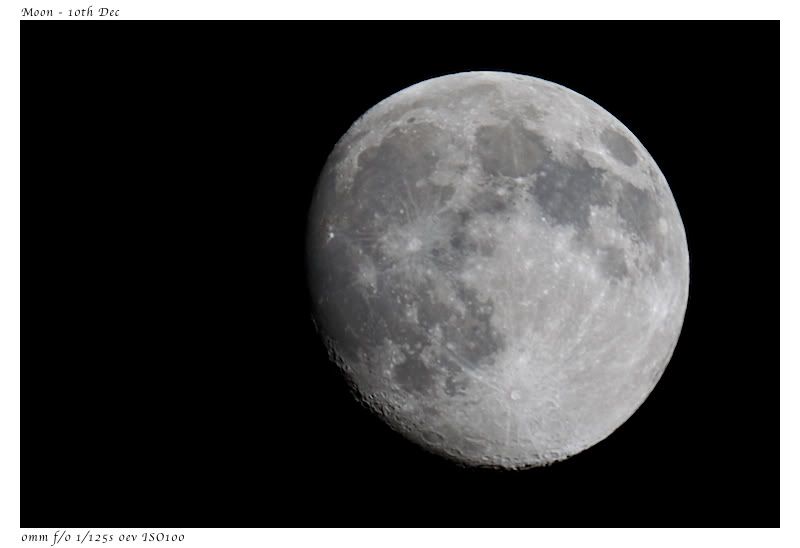
I can't see any evidence of CA in these images. One thing they do show, is just what a good combination the 450d with the 55-250 really is.
After my outing, I was able to get the scope out for an hour. I carried out my normal NexStar level and align, only using a Solar System align on the Moon. I really need to work out what the centre of the moon is for alignment, as the view always drifts about when I do this.
Anyway, the view through the Ortho was quite amazing, and I was able to focus with just the mirror diagonal, no extension tubes needed. I then swapped to the 5mm Hyperion, and the view took my breath away. Amazing amounts of detail showing through, that with the Konus I've never seen before. I then decided to push it to see how far I could go. I put both tuning rings in the Hyperion, making it a 2.5mm ep, and giving 240x magnification. Now by all logic, this should be seriously overpowering the scope and on that basis the view should have deteriorated. I have to say, that I could see no difference in the view, apart from getting that much more closely in. The craters all looked really refined. Aristarchus and the nearby Schroeter valley looked amazing and clear, with well defined edges. Seeing was somewhat wobbly, but didn't interfere too badly. I just went for a little tour around the terminator, and was surprised to see some of the surface features away from the terminator, that in the Konus showed no real definition, appears quite clear in the C80ED.
I then changed to try some webcam imaging. And shot a series of different avi's at various focal lengths, using just the webcam, the x2 barlow and the x5 barlow. I was able to achieve focus without using any extensions at all the focal lengths. I have yet to process them, and I'm not 100% I got the settings right, and the drift may have a negative effect on the resulting image once processed, but it's all good experience, and clearly shows to me how much easier this scope is to use.
Then I had to pack up, as my powertank was flagging and the clouds moved in.
I have to say, I'm really impressed with this scope, and I'm really glad I grabbed it before stock ran out, as the prices was excellent. I'll post the webcam images once processed.
Sunday, 7 December 2008
Sharing the Bins, some Moon shots and reprocessed M42
Had some friends around last night, so, whilst it was clear, crisp and cold, I didn't get out for a proper session. However, I did manage to persuade them to come out and have a look through the bins. I set the 15x70's on a tripod, (that way I could aim it, much better for them to view), and pointed them at M45. Then I had each person look, and find the cluster naked eye and see what could be seen like that, then through the bins. Each person was amazed at the extra detail that could be seen.
At their request I then pointed the bins at the moon and again exclamations of astonishment ensued as they looked and could clearly make out some crater detail (not as much as you would at 160x on the scope, but hey...)
And finally I turned the bins on Jupiter. The Planet became a clear disk, as opposed to a point and a couple of moons were visible. Again some astonishment ensued that you could make out the moons.
No one was dressed for the conditions, the floor was really quite icy, so at that point we went inside, with a promise that we would get together again with the scope out for a better view of the moon and sky.
I managed to get some moon shots earlier yesterday.

I can't decide which of these I prefer... I think probably the landscape one.

And finally, I've had a bash at reprocessing my image of M42 from the original stack. I tried to get the core detail from the short subs, but the Konus isn't able to resolve the stars, I don't think the optics are quite up to it, but the overall image is much better with more detail.
I'm not going to spend any more time on trying to get more out of this. I'm happy with it as it stands.
Wednesday, 3 December 2008
Contact, and some Moon and Planet shots
I was working away earlier when my Neighbour called me up, as her sister was looking at getting a telescope as she had always been interested in the Night Sky. They'd seen a couple in Jessops would they be worth it ? I suggested that it would probably be best to leave it and I'd have a talk to them this evening. Anyway, I had to pop out for a while, although the Moon looked rather special, with Earthshine still just about visible, and Jupiter and Venus were shining brightly in the night, I offered to cart my gear around so they could have a look and hopefully see some sights weather dependant of course.
I got back, and did what was needed at home, then begin to take it all next door. I could see that the mist was working it's way in as the moon was getting swathed in it, so rushed to get everything there. I setup the 15x70's in the tripod, and pointed them at the Sisters as it's such a jewel of the night sky, I figured if anything was going to convince, given the conditions they would. Whilst they were looking, and oohing and aahing, I setup the scope. It's damnably hard to align the goto when the mist is obscuring a lot of the brighter stuff. Anyway I did a rough align on Polaris, knowing it was going to be out and tracking wasn't going to be ideal and slewed to the Sisters also, a bit of an adjsutment and there they were. Disapointing really, due to the mist, but when you consider that without the optics, we could barely see them, they still showed at least a dozen of the brighter stars.
After struggling to view for a few more minutes, and unpacking the 60mm frac, as that's what she was looking at in Jessops, we packed up and went in for a bit of discussion. I also showed a couple of websites for the gear. For now, she's going to get a pair of 10x50 bins, if she hasn't already got some, probably a 60mm AltAz Celestron and a copy of Turn Left at Orion, and see how she gets on.
Earlier on I had managed to get a few tripod mounted shots of the clear skies..
The Moon

Jupiter and Venus, this has some of the Galilean moons in
And a widefield of the three
Conjunction and the ISS
I nearly managed to get the Occultation on Monday, but missed it by a few minutes. I thought I was late, but in fact I was early, that's irritating.
And a shot of the moon, Earthshine showing, with Jupiter nearby
And from last night the ISS. I did try to get the toolbag, but it wasn't on the shot.
Monday, 24 November 2008
Freindly Bino view
There were some gaps in the clouds yesterday evening, and a friend and I had a few minutes out with the 15x70's. The Seven Sisters were strutting gloriously across the heavens in their inimitable fashion, so we spent some time looking there, a look at Mirfak for the association, and the Hyades. All this in the gaps between the clouds. It wasn't a long session, but my friend was astonished at the numbers of stars visible in the bins.
Saturday, 22 November 2008
Running man past the birdie
Or, capture M42, M43 and the running man...
Orion was just clearing the roofline when the clouds parted and cleared off. Even though it was quite late, I decided I needed to know if my corrective actions had worked and whether I was going to hit all sorts of tracking errors again or not. I setup, levelled, aligned on Betelguese. Waited a couple of minutes and took a 90 second shot. Spot on. No noticeable trailing, no tracking errors from the mount. Phew... I used the goto to slew to M42 and left it for 10 minutes to allow M42 to clear the roof line. I figured that rather than waste the time, I'd shoot my flats and flat darks so did that as usual.
Using the time remote, I captured a sequence of frames varying from 2 seconds for the trap to 45 seconds. Total time 875 seconds or 14.5 minutes. Captured with darks (only 10 of each, should really have gone for 15) and a total number of useable frames of 47. Only lost 3 to trailing and one to tracking errors. Orion is sadly too far south for longer exposures by the time it's cleared the roofline, and trailing becomes a significant issue.
Anyway, I threw the whole lot of frames into the DSS mixer, set to blend and left it to it. Then used PS to stretch and tweak resulted in
Ok, I've blown the trap, I wasn't sure how that was going to come out, but I will stack the short subs to pull out that detail and try and merge them together in PS. It's also a little noisy, I think for ISO1600 I really need more dark subs. However, I'm really pleased with this result, but will revisit to see how much further refinement I can achieve.
Thursday, 20 November 2008
A couple of the moon today
Nothing doing last night. To much cloud around, not enough gaps. I couldn't be bothered setting up, so I went out for a beer instead. However, this morning, clear, bright, blue skies and the last quarter moon hanging there. I grabbed a couple of shots...
The first is the moon on it's own...
The second, I spotted the vapour trail heading in the right direction for a close pass, and grabbed the camera just in time...
Wednesday, 19 November 2008
Pulling my hair out
What a mare last tonight. My double flare was spoilt by clouds. The planets shots were all poor... looks like some movement in the camera, I'd probably have done better hand holding it. This is the best one
Since "balancing the scope" I'm getting tracking errors at only 30 seconds.... Never mind any longer. I shot a bunch of subs of M42 tonight, and only 1 x 2 minute sub it usable. Anyway, suffice it to say, that to top it off, the clouds moved in around then. I've put everything back how it was and I just hope that's cured it.
Anyway, here's the image from the single 2 minute frame. Not done much with it to be honest... The green tint is the CLS filter, that the DSS stack normally removes.
However, the high point of the night, whilst I was trying to work out what was causing my tracking errors at about 2220, and waiting for an exposure to finish, I glanced around and saw a fireball shoot across the sky. It was heading sort of from the Pleiades towards the South West ish, the track ran across about 40 to 50 degrees of the sky, and I watched it break up and disintegrate leaving behind a trail in the air that dissipated quickly.
Tuesday, 18 November 2008
I've done it again
I managed to get another image on the S@N cover disk. I can't quite believe it, but two in a row. This time it was my double flare shot.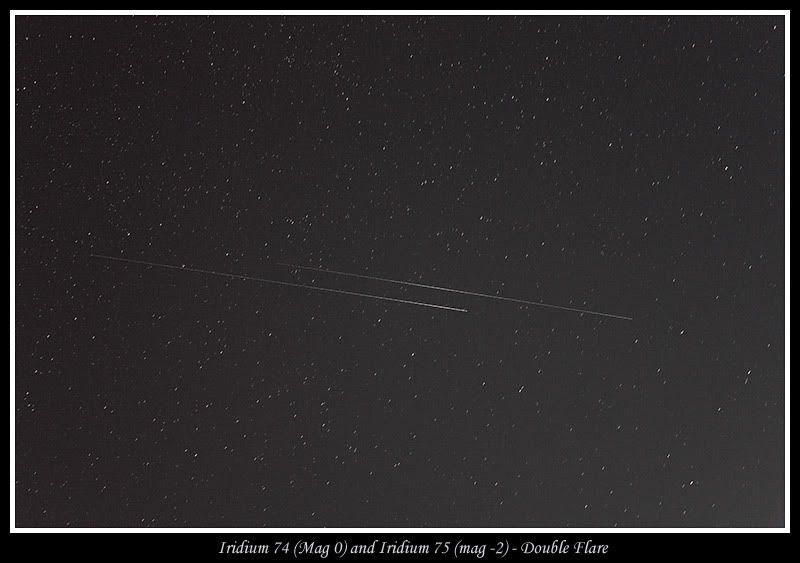
Monday, 17 November 2008
Clear Sky... Nearly
Last night, after another grim and grey day, the sky actually cleared. I managed to get a handheld shot of the moon, although it was a little misty.
I went inside to do a couple of things, and checked again a few minutes later, and yep, the cloud was back with a vengeance. I'd been planning on setting up the bins, to show my OH the Pleiades, to see if I could at least engender a little appreciation for the wonders of the night skies, as opposed to looking online at pics. And hopefully grabbing a stack of M42/43, but this wasn't to be.
Wednesday, 12 November 2008
Shooting the Moon
A couple of shots of the moon in gaps in the clouds from the previous nights.

A clear night yesterday, and the Moon was nearly full. I got out and grabbed a shot with the camera and 55-250 lens handheld earlier on
I got the scope out later, levelled, powered up and aligned on the moon, then on to use the webcam to try and capture the lunar surface closer up. I had a real headache getting everything setup. I couldn't remember the tubing required on the focusser to allow me to get focus, I couldn't get the right settings in wxastrocapture to enable to get a reasonable preview on screen. After about 50 minutes of faffing I managed to get the right combination of tubes and settings and there she was on screen. Phew.
Then onto focussing. Well, that was another major headache. Whilst the drawtube no longer moves up and down (there's still a little play visible when using the 5x barlow, but not enough to be a problem) there's no fine tuning and getting precise focus is tough, add in poor conditions and it was horrible. After yet more faffing I finally got it as close as I was going to, and started capturing.
I ran off a bunch of avi's. Firstly at 800mm on Aristarchus, then at 400mm to capture four sets (although it ended up being 5 due to drift) and compose as a mosaic, then a final 800mm on the terminator.
Time passed whilst all this capturing was going on. I then swapped out the webcam for the 450d, using the OM mount 2xTC to get some image scale, and the 10x preview on liveview. Focusing was really hard thanks to the conditions, I've had it much easier to focus the moon before in this config. Anyway, here's the not great result
I started trying to process the AVI's this morning, and followed my previous routine for processing them. Went through, clicked on the option to debayer (RAW modded webcam) and the picture on screen turned to mush. It didn't matter what options I tried it did the same thing. I then tried aviraw to convert and that showed exactly the same symptoms. I stacked the image anyway, using single point, I still can't get multipoint to produce anything other than broken segments, and adjusted in wavelets. The image still shows the Bayer matrix pattern across it, but it did work.
I ended up comparing my old config to the new one, and found that the capture format was set to RGB24 on the new machine and YUV420 on the old. I reckon this is the problem. I don't know if all the AVI's are wasted or whether I can find something that will debayer them for me, but the hunt is on.
Friday, 7 November 2008
I saw the sky
The clouds actually parted on and off today. I was surprised as the forecast was supposed to be rubbish. Anyway, I saw the moon rising quite early on, early enough for the sky to still look light blue.
Having checked on HA, and found a flare prediction at -4, I grabbed the SatCatcher and decided to go for it. 20 minutes before the prediction, the sky was clear, 10 minutes before, rain, then a couple of minutes before it cleared. I dashed out setup and caught it. The flare didn't reach -4 though.... and it looks like I must have mucked something up on the SatCatcher whilst is was in storage...
The moon was now higher and against a dark sky...
A little later, after another band of cloud had passed through, the sky was once again clear. I grabbed the scope and all the paraphenalia and setup. A quick align on the moon, popped in the webcam with the 5x barlow, attempted to focus... hmm nothing... I looked up and the clouds were back in force again... so I packed up. I've still got to test this setup out. Hopefully soon.
Tuesday, 4 November 2008
Visit to the Adur Astronomy Society
I managed to get along to my first meeting of the Adur Astro Society last night. Bit of a rush to get there on time, but what isn't nowdays  . I must say, a very friendly and welcoming bunch indeed.
. I must say, a very friendly and welcoming bunch indeed.
Robin kicked off with a welcome, before handing over to Ed, who provided a useful run through of some of the better and easier to find visual objects, in a video he'd prepared earlier and giving insights and on screen computer generated images into the expected views that one can expect.
Ed, handed over to Steve, who followed with a similar presentation, this time, concentrating on imaging targets for the coming month, accompanied with images he had prepared to show the sorts of results that could be achieved.
Then back to Ed again for a detailed look at some astronomical filters. Discussing what each filter could/should be used for, how they enhance the viewing experience and what can be expected to be seen using them.
After tea and cakes (Cracking carrot cakes, made be Leanne I think ![]() )
)
the floor was opened to members to present where they were at and advice could be sought. Robin, also ran through a presentation, with details of his gear and results from the various cameras.
Bern from Modern Astronomy was also there with an interesting looking array of equipment. I'm sad to say that I steered well clear, the CFO would have shot me had I gone near, cos I would probably have ended up buying something... (Sorry Bern  )
)
Trev did a sterling job in the background, providing technical support (I think it was his laptop in use) and tea duties  .
.
Thanks Robin, Ed, Trev and Steve for the work and effort put in to organise the evening, a very useful and enjoyable evening out, just a shame the weather is back to it's dismal usual self again.






